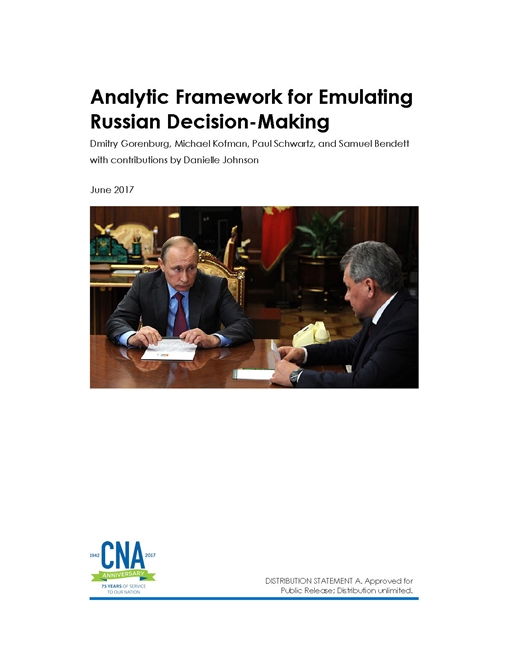In this report, the CNA Russia Studies Program develops a framework for the emulation of Russian senior-level decision-making in the national security realm. The goal of the report is to help emulators develop an understanding of factors that affect Russian decision-making processes and how these processes influence military operational planning in the European theater. In the first section of the report, we present the analytical framework. This is followed by three case studies that examine how the framework could be applied to three potential crisis scenarios in Eastern Europe. The case studies are designed to demonstrate how the analytical framework could be used to emulate Russian decision-making in a crisis situation.
This framework is derived from several sources: what we know about Russian decision-making, what we know about how rational leaders calculate risk, the behavior of states in the international system, and distinct elements of Russian strategic culture, i.e. the prism through which Russian decision-makers approach their strategic calculus. The objective is to be explanative, parsimonious, and fuse the best of regional studies expertise with the work of the security studies community. We offer a base model for Russian decision-making and ways of thinking about Moscow's strategic calculus in conflicts that may subsequently be applied to hypothetical crises. It is not a simple derivation of actions Russia may take, or cards that Moscow plays in particular scenarios, but rather an analytical roadmap that aids in emulating a complex adversary.
Key elements of the framework
The model begins with a strategic assessment by Russian leadership of the situation and how it fits into the grander scheme of their security concerns, ambitions, strategy for the region, and geopolitical confrontation with the United States. The strategic assessment serves as an intellectual template or base for Russian decision- making in the scenarios explored subsequently in the paper. We then develop strategic objectives that serve as guidelines for Russian national security decision- making in crisis, what they wish to achieve, prevent, and over the horizon goals that influence short term decision-making. They are rooted and derived from three principal Russian foreign policy motivations: maximizing security which results in pursuit of extended defense, maximizing power, reflected in the quest for regional hegemony, and maintaining great power status in the international system, a fixation that shapes foreign policy outlooks. The last driver in particular is one of historic patrimony inherited from the Russian Empire and the Soviet Union.
Strategy in conflict is focused discussion on the ways by which Russia's national security establishment seeks to achieve its objectives in a crisis. This is both an elucidation of Russian strategic preferences, which are typically emergent and less deliberate. Strategy is not a deliberate planning process, so much as a focused conversation on how Russia would construct a theory of victory, and attain leverage in a particular crisis. The preference for indirect versus direct approaches at first to keep costs low and mitigate risks, and a predilection for brief use of force to coerce and compel adversaries. Russian strategy as described here is iterative, and dynamic, offering sample answers and a method by which to emulate such discussions.
The second part of the framework lays out the process by which the Russian leadership would develop a plan of action for dealing with the crisis at hand. It begins by establishing the range of goals that Russia may seek to pursue. We define what should be considered maximalist goals that Russia may look to attain if given the opportunity, versus minimalist goals that are the base requirement for Moscow to feel satisfied with the outcome of a conflict. These goals in turn lead to a range of potential courses of action (COAs) Russia could take in response to a crisis situation. Russia employs COAs to achieve operational objectives that flow out of a given Russian strategy in conflict. Each one is tied to a given theory of victory, and includes a series of actions that Russian leadership believes will secure their objectives based on that particular theory.
The third part of the framework examines potential problems that the Russian leadership may face, and core weakness or risks that shape its decision-making, beginning with an examination of Russia’s vulnerabilities in the situation. Vulnerabilities serve as constraints on Russian COAs, affecting the Russian government and military’s ability and willingness to escalate a conflict to achieve maximal goals versus de-escalating to avoid potential negative consequences. We then address Russian red lines and escalation points, structuring the discussion in terms of 'theories of defeat' or what happens when Moscow realizes that its strategy in the conflict has failed. While there is no actual theory of defeat in Russian military or strategic thought, the concept is intended to be a useful analytical exercise in emulation to force a conversation on a critical question: at what point does the Russian leadership believe that its given strategy in conflict has failed, and what is it likely to do next?
This analysis leads to a set of potential exit and/or escalation strategies that allow Moscow to manage potential risk in a crisis scenario. The framework for each case study includes a set of decision-trees that highlight how Russia might respond to potential actions by other actors. The analysis also accounts for black swans, events that may impose new political realities, lead to escalation or a new confrontation between the parties, and begin to add new potential paths for the conflict to deviate unanticipated by those involved.
Download reportDISTRIBUTION STATEMENT A. Approved for Public Release; Distribution unlimited.
Details
- Pages: 116
- Document Number:
- Publication Date: 6/29/2017
